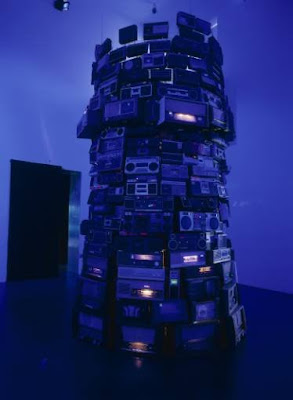 Simon Reynolds kicked off a week of posts about The Sweet with the provocative question 'was there in fact a better British hard rock vocalist of the 1970s than Brian Connolly of The Sweet?'. Of course die-hard 1970s rockists would have been horrified at the very suggestion of admitting The Sweet to the hard rock canon - a glam pop band who didn't even write their biggest hits.
Simon Reynolds kicked off a week of posts about The Sweet with the provocative question 'was there in fact a better British hard rock vocalist of the 1970s than Brian Connolly of The Sweet?'. Of course die-hard 1970s rockists would have been horrified at the very suggestion of admitting The Sweet to the hard rock canon - a glam pop band who didn't even write their biggest hits. The band even had a proto-punk attitude several years before The Sex Pistols, as Chinn recalled: 'We were doing "Ballroom Blitz" on Top of the Pops, and all day Steve [bassist Steve Priest] had been acting a bit strangely. After the opening bars of the song, he turns round with his back to the camera, and on the back of his leather jacket were the words FUCK YOU'. Unsurprizingly, this was never broadcast by the BBC.
 Even their gender bending is often derided, because unlike Bowie they didn't learn it from Lindsay Kemp. They are sometimes bracketed with Slade as 'brickies in eyeliner' (to use Siouxsie Sioux's memorable phase). But for a generation of pre-pubescent children like me watching in awe on Top of the Pops it probably had a bigger impact than Bowie, if only because they were so ubiquitous. As glam blogger the Stardust Kid puts it: 'In most respects glam rock is totally fake, but to young kids like me it was real and alive. It may have been 'Brickies in eyeliner' but to the kids it was 'stardust for the dudes''.
Even their gender bending is often derided, because unlike Bowie they didn't learn it from Lindsay Kemp. They are sometimes bracketed with Slade as 'brickies in eyeliner' (to use Siouxsie Sioux's memorable phase). But for a generation of pre-pubescent children like me watching in awe on Top of the Pops it probably had a bigger impact than Bowie, if only because they were so ubiquitous. As glam blogger the Stardust Kid puts it: 'In most respects glam rock is totally fake, but to young kids like me it was real and alive. It may have been 'Brickies in eyeliner' but to the kids it was 'stardust for the dudes''.I'm not sure I would go as far as Barney Hoskyns in suggesting that The Sweet influenced black American style from George Clinton to Prince, but who know maybe he's right that 'Space-age glam also played a large part in the look of P-Funk. George Clinton was funk's own Roy Wood, while Bootsy Collins - the rhinestone-encrusted overlord of space bass - was the Sweet's Steve Priest on Pimpmobile overdrive'.
From Youtube - The Sweet on Top of the Pops in 1973 performing Blockbuster - all silver platform shoes and gold catsuits. The band were sometimes accused on stealing this riff from David Bowie's Jean Genie - in fact both of them probably took it from The Yardbirds 'I'm a Man', itself a cover of Bo Diddley - orginality is often over-rated!






 Both balls employed private stewards to maintain "order" and exclude "undesirables." From 1933, having failed to secure a police presence, Malcolm employed two ex-CID officers to remove any identifiable "sexual perverts." From 1935 tickets were sold with the proviso that "NO MAN IMPERSONATING A WOMAN AND NO PERSON UNSUITABLY ATTIRED WILL BE ADMITTED". On entry, men's costumes had to be approved by a "Board of Scrutineers." Whatever they tried, however, the organizers could neither keep the "Degenerate Boys" out nor adequately contain their visibility; indeed, they often struggled even to identify them amidst the fancy dressed crowds. In 1938, an observer thus described the "extraordinary number of undesirable men at this Ball who were unmistakably of the Homo-Sexual and male prostitute types." Well into the 1950s, the balls remained, in Stephen's words, "a great Mecca for the gay world."
Both balls employed private stewards to maintain "order" and exclude "undesirables." From 1933, having failed to secure a police presence, Malcolm employed two ex-CID officers to remove any identifiable "sexual perverts." From 1935 tickets were sold with the proviso that "NO MAN IMPERSONATING A WOMAN AND NO PERSON UNSUITABLY ATTIRED WILL BE ADMITTED". On entry, men's costumes had to be approved by a "Board of Scrutineers." Whatever they tried, however, the organizers could neither keep the "Degenerate Boys" out nor adequately contain their visibility; indeed, they often struggled even to identify them amidst the fancy dressed crowds. In 1938, an observer thus described the "extraordinary number of undesirable men at this Ball who were unmistakably of the Homo-Sexual and male prostitute types." Well into the 1950s, the balls remained, in Stephen's words, "a great Mecca for the gay world."







